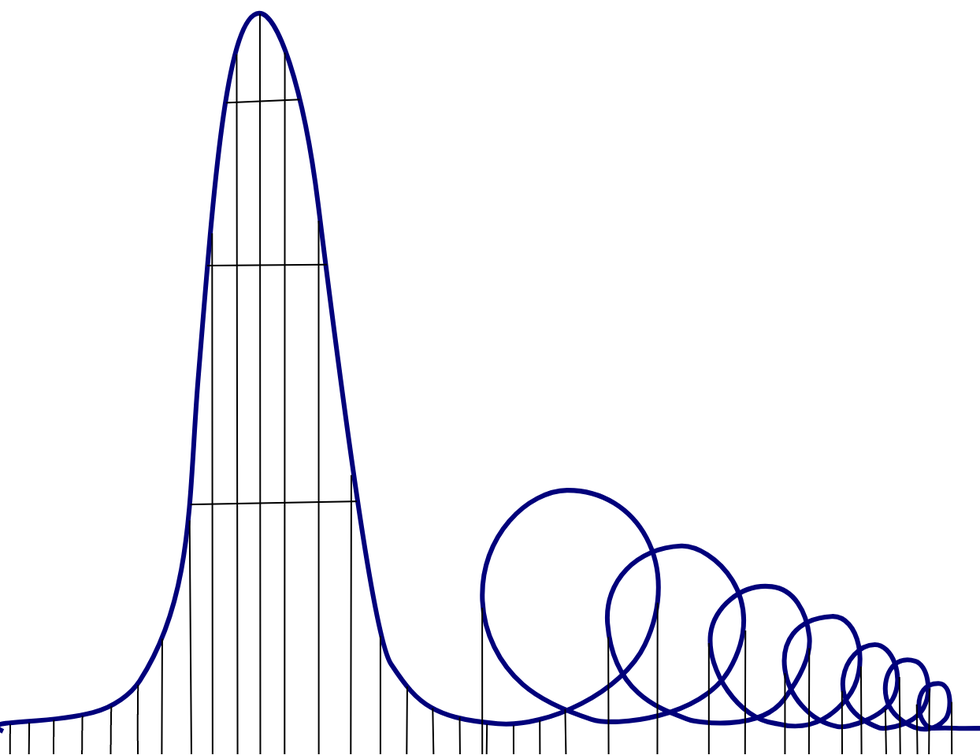Ever since I was tall enough to ride, I’ve been a major roller coaster fan. Growing up in Pittsburgh, my family frequented the local amusement park, Kennywood, several times each summer. The first time I got to ride the Phantom’s Revenge in the early aughts, I was uncharacteristically squeamish—the coaster’s predecessor, the Steel Phantom, was not only the world’s fastest roller coaster at the time of its opening in 1991, but the reason it closed down and required a facelift was due to the number of complaints from riders about neck pain and headbanging throughout the ride’s four inversions.
Despite the ride featuring zero inversions by the time I took a spin, those twisty moments of upside-down terror immediately came to mind when I first heard about the Euthanasia Coaster, “a [hypothetical] death machine in the form of a roller coaster, engineered to humanely—with elegance and euphoria—take the life of a human being.”
Yes, you read that right: a highway to hell, a one-way ticket to the pearly gates, a fast-track to the void. The coaster’s creator, Julijonas Urbonas, is an artist and associate professor at Vilnius Academy of Arts in Lithuania and a former director of a Soviet amusement park in Klaipeda, a Lithuanian port city. He debuted the project in 2010 as a type of thought experiment, though research in aeronautics and space medicine, mechanical engineering, materials technologies, and gravity all informed Urbonas’ work, which he presented at a 1:500 scale in etched brass, plywood, and carbon fiber. He claims on his website that the ride really would lead to death if constructed at a life-size scale, and apparently, it would be a far more pleasant experience than riding the Steel Phantom.
It would go something like this: Harnessed into your seat with a health-monitoring system, your single-seat coaster cart would slowly climb to the apex of the half-kilometer-tall ride (that’s roughly one-third of a mile high!). It would take a few minutes, giving you a moment of respite from the world below, and a final chance to contemplate getting off and returning to normal life; if you decide to proceed, you press the “fall” button, otherwise, enjoy the long stairway down. As you drop at 220 miles per hour, you hold your breath and experience vertigo, “comprising a sort of fairground anesthesia,” Urbonas says.
✅ Get the Facts: Assisted Suicide
Assisted suicide is a highly controversial topic in the U.S. You can break it down into two general categories: physician-assisted suicide, which involves a doctor helping a person take their own life if they request it, and euthanasia, which is when a doctor ends a person’s life in a painless way with approval from the individual and/or their family. Euthanasia may be voluntary (a patient makes consistent, thoroughly considered requests to die), involuntary (a patient is killed against their will), or non-voluntary (a patient cannot give consent to die because they are incapacitated). The Euthanasia Coaster would fall under voluntary euthanasia, and if it were real, you’d need a doctor’s approval to get your ticket.
However, that would be pretty difficult depending on where you live. As of 2020, assisted suicide is legal in 18 jurisdictions, meaning around 200 million people can access euthanasia or physician-assisted suicide, according to a review published that same year in the Annals of Palliative Medicine. In Europe, there’s been an increase in assisted suicides in Belgium, the Netherlands, and Switzerland, and in the U.S., states like Oregon and Washington have long-standing laws on physician-assisted suicide.
As you enter the first loop, you’re falling so quickly that the force of the air drag equals the force of gravity, canceling out acceleration. You’re completely inverted in the 360-degree circle as your breathing becomes labored, all while your ribs and internal organs are pushed down, squeezing out air from your lungs. At this stage, you’re probably unconscious, Urbonas notes, because the great force of the inversion (pulling 10 Gs) has pushed your blood to your lower extremities, causing an oxygen deficiency in the brain. “It is exactly this cerebral suffocation, also known as cerebral hypoxia, that is going to kill you,” he says.
If you’re still alive, rest assured that the loops are engineered to maintain constant force despite changes in speed so that you don’t experience any painful acceleration; each loop gets smaller in diameter to maintain that 10-G force as the coaster decelerates. Your vision will blur, you may stop seeing color (a phenomenon called a “greyout”), tunnel vision will set in, and you may black out altogether and lose your hearing. This eventually leads to G-LOC, or G-force induced loss of consciousness, in which your body goes limp and your mind basically trips out. During the last five or six loops, your body is numb and you almost certainly die by the end of the ride. The health-monitoring system checks your vitals to see if you do need a second ride, but that’s pretty unlikely at this point, considering each of the loops is a perfect death trap.
It’s not a ride most of us would deign to consider, but for the terminally ill, it’s a truly fascinating concept that sort of reminds me of the Sarco suicide pod, a very real technology for assisted suicide.
In any case, I’ll never look at safety signs at amusement parks the same way again. (And neither should you—in late June, a North Carolina amusement park shut down a coaster after a rider noticed a crack in its steel support beam; never take your safety for granted!)














